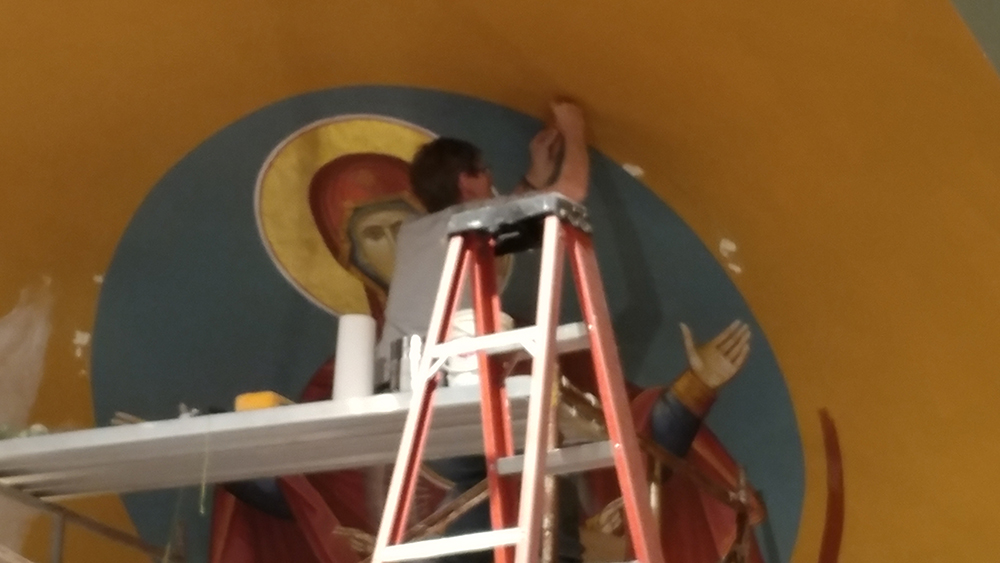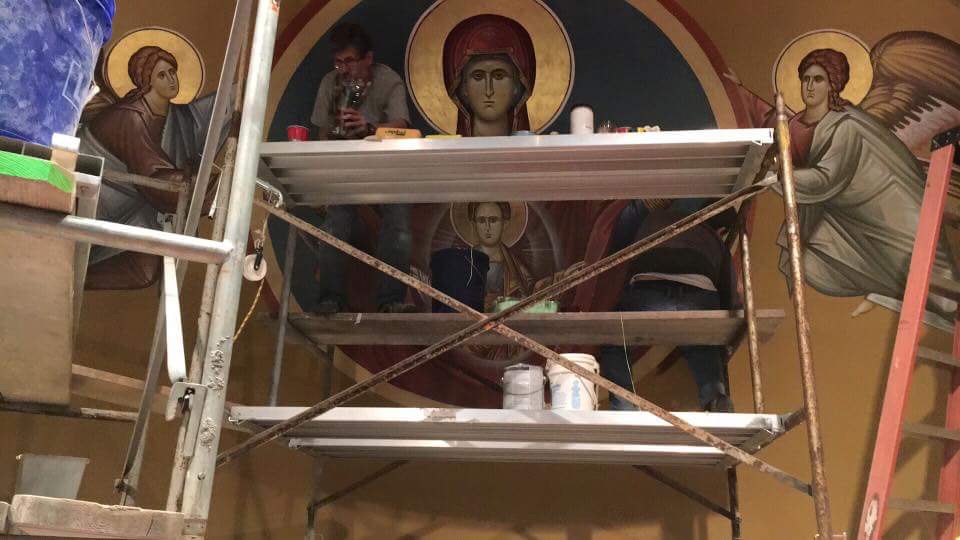
|
1st Sunday with Platytera Up This has been an exciting and busy week in our parish! I trust you are inspired with the long awaited Platytera Icon with angels that now graces our altar cove. Painted in the traditional Byzantine style, Christ (depicted) as a young child seats on Panayia's womb - often called "Christ the Emmanuel" He who is with us - meaning "God with us." Holding up the medallion of Panayia with Christ are 2 of the archangels - Michael on the left and Gabriel on the right.
To accomplish all this - the pipes previously there, were cut back...425 of them and then the cove was re-plastered, in fact 3 layers of plaster. Each had to dry of course, so last Sunday you noticed as we did the liturgy on the solea (outside of the altar due to the scaffolding in the altar), the church was very hot - at 77, in fact early in the morning on Sunday we opened the side doors and the windows to cool it down a bit. The artisans started the project in earnest on Tuesday morning Nov 15 the first day of Advent, and thought they would have the icon up last Friday, perhaps Saturday for sure. (The icon was previously painted on canvas and ready to be clued on the surface.) But on Wed & Thu the furnace kept shutting down and would not heat up, to dry the new plaster, even though the previous weekend it was serviced and in proper working order. I truly believe that Panayia did not want to be placed in the cove on what would have been Nov 18 or 19, but rather wanted to enter our church, on her feast day, on Nov 21, that of the Entry of the Virgin to the Temple in Jerusalem which in fact occurred this past Monday afternoon - evening after the feastal liturgy. I pray beloved, that the vividness of this icon will be inspiring and comforting to you. It is warm as opposed to the cold pipes previously there. It is all embracing as well....as you enter the narthex and look straight ahead and her hands are outstretched. It fills the space so perfectly.
Let me share with you that the project is not over.....there is a 2nd group of painters who will now come in to restore the surrounding space with the sparkling texture as previously there. They will begin tomorrow and the altar will once again be sealed and perhaps next Sunday we might again need to serve the Liturgy on the solea, but that is to be determined. Let me also use this day to say a few things about our Orthodox iconographic tradition ... Byzantine Iconography is the art of the early Church. In fact St. Luke was the first Iconographer. He painted icons of the Virgin Mary Jesus, some of which still exist today. We call icons “the Bible of the Illiterate” because during the middle ages when not everyone could read, people were still able to understand the message of salvation through pictures. What the Bible reveals about God through words, icons reveal in pictures. Icons are not idols, they are "windows to heaven". They reveal the reality of God’s kingdom on earth. They make visible the invisible. With this in mind, we decorate our churches to serve as inspiration. The church building is a "small" Kingdom of heaven and these are the people we will see in heaven. When we enter an Orthodox Church, we are leaving time and space and entering eternity. You look up and see the dome. This physically represents the heavens, Christ the all powerful the Creator of all (PANTOCRATOR) is there looking down on His creation. If you consider it the beginning of time, we find there Christ the pre-eternal word, the logos, the second person of the Trinity. In the Apse, above, or behind the altar we have the Virgin Mary holding the Christ child (which we just installed here in Cranston!) We call her in Greek, PLATYTERA - more expansive than the heavens, because she contained within herself, the creator of the universe. Fr Anthony Salzman, our iconographer, who was with us all last week writes the following... Icons are not works of art per se. They always are used within a context of worship, whether at home or in the church. We call it “Hagiograhia” or “Holy, or Saint writing.” “Grapho” means to write. So we are writing the gospel with a brush.
Icons are painted the way they are on purpose. Their flatness and expressiveness make them alive and engaging asking the viewer to participate and interact with them. They do not create an illusion of space, but use reverse perspective to come out to the viewer. They do not use foreshortening, but draw people in profile or frontally, thus maintaining the integrity of the two dimensional surface. Two elements constitute and icon, line and form. We draw exactly what we will paint before we pick up a brush. Once we have the entire image drawn out, and the expression resolved, then we begin to paint. They are not sentimental but expressive. They do not show the human being as fallen, but they transcend physical reality to reveal a deeper reality, a transformed reality. That is why not every icon looks exactly the same, we are not copying physical reality, but trying to capture something deeper. If an icon moves you in your spirit to glorify God, then it has done its work. If it brings you to repentance then you have become sensitive to its reality. Byzantine icons lead us to God and they bring God to us. Yes beloved - it has been an exciting and significant week in our parish, one that will last beyond our life time! + Fr. Andrew
|



